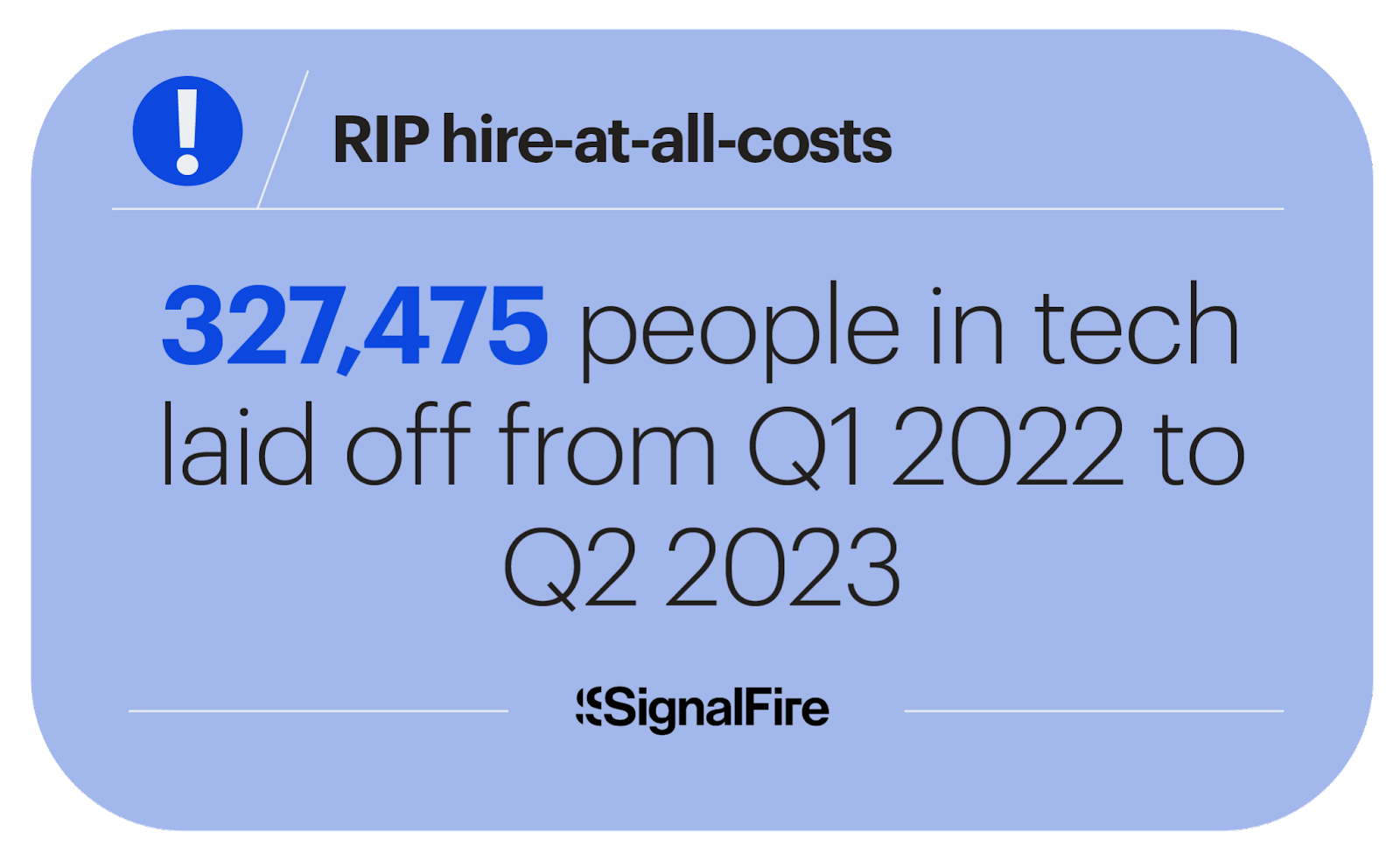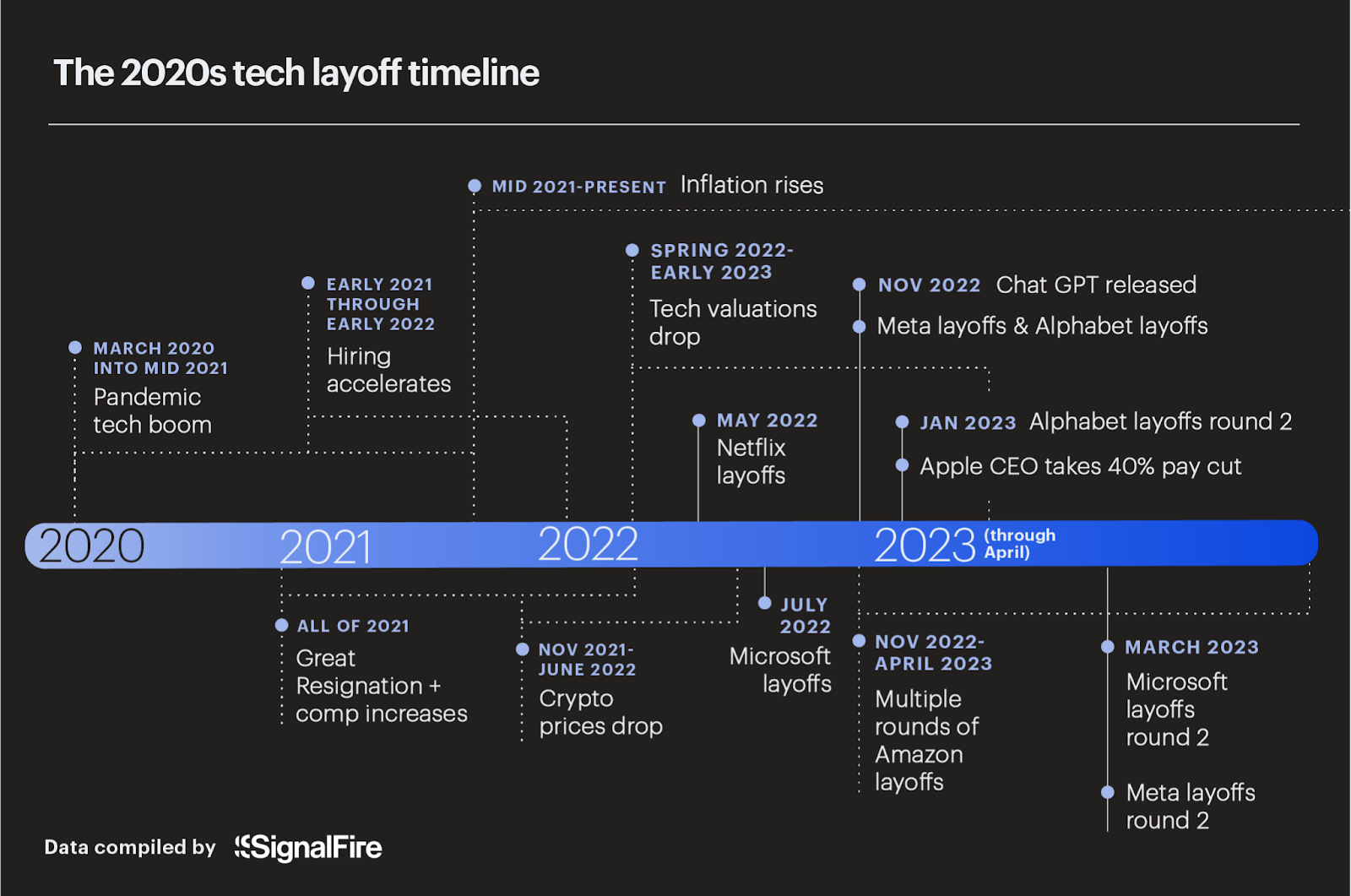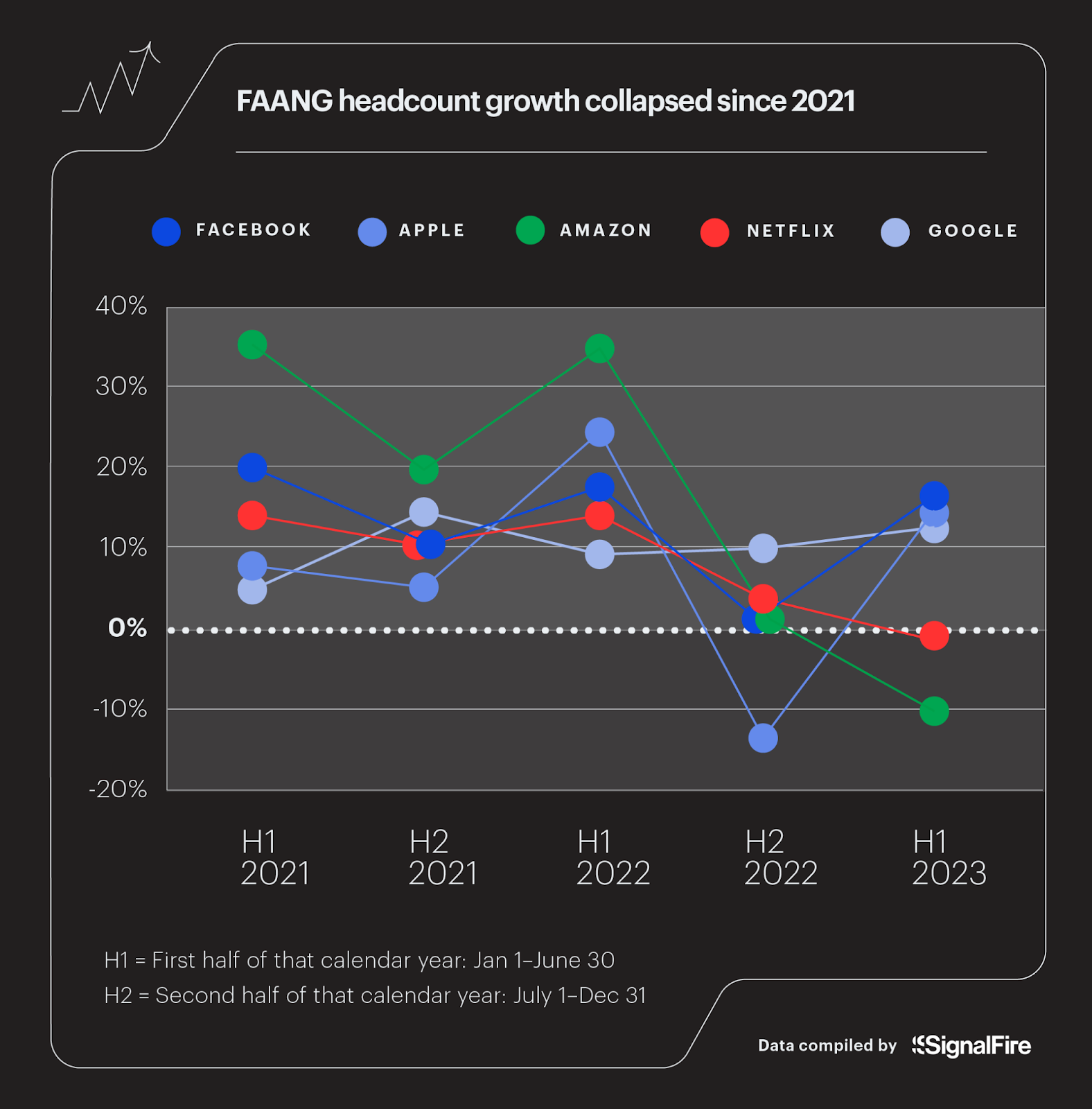The era of tech giants overstaffing and overpaying has ended, at least for now. But talent is flooding the market, and those still employed have been left to shoulder all the work — there’s a huge opportunity for savvy recruiters to scoop up top performers.
Today’s job market is a confusing paradox. While unemployment is at a record low and there’s a labor shortage in healthcare and hospitality, tech has seen nonstop layoffs that hit 166,044 workers in Q1 2023 alone. That’s more than all of 2022’s then-record 161,411 tech layoffs.
What’s most unprecedented is that these layoffs are hitting software engineers, including top talent at FAANG companies that were previously considered untouchable. This is in sharp contrast to the 2008 recession, when the U.S. high-tech industry gained about 77,000 jobs in Q4, most in software development, despite the overall U.S. labor market losing 38,000 jobs.

327,475 people in tech were laid off from Q1 2022 to Q2 2023. Image Credits: SignalFire
The reversal of fortunes for engineers is particularly brutal coming off of 2021’s startup fundraising boom and relentless optimism. Companies preempted growth with hiring sprees far ahead of their metrics in hopes of continued growth.
But by the summer of 2022, the Great Resignation and “quiet quitting” gave way to mass layoffs by four of the big five in tech — Meta (Facebook), Apple, Amazon, Netflix and Alphabet (Google), known as FAANG. All but Apple made sizable cuts, including deeper cuts for software developers.
Executive summary
SignalFire’s State of Talent Report explores macro conditions and top-talent movement trends in tech to identify practical strategies for winning in the current hiring market. Top findings include:
- Hiring power is shifting to startups as post-pandemic layoffs and budget cuts cause a “Great Restart” of compensation norms at Big Tech companies that can no longer overpay to win the best talent.
- An unprecedented 166,000 tech layoffs happened in Q1 2023 — more than in all of 2022 — and included formerly untouchable software engineers.
- Big Tech talent has flooded the market — 69% of FAANG engineers who were laid off or left after May 15, 2022 still listed no current job as of March 15, 2023.
- 28% of rehired FAANG engineers played musical chairs and switched to another tech giant, while 6% went to early-stage startups — an 82% increase over 2021.
- Startups can capitalize on this power shift by recruiting passive talent who have survived Big Tech layoffs — they’re often loyal top performers who are overworked after teammates were cut.
- SignalFire can help startups find and hire top passive talent with its Beacon AI engine and recruiting team.
View the State Of Talent Takeaways deck for more highlights.
Mass layoffs and the “Great Restart”
To explain the tech talent market’s sudden implosion, here’s the timeline that led to an imbalance in talent supply and demand.
Tech has seen nonstop layoffs that hit 166,044 workers in Q1 2023 alone. That’s more than all of 2022’s then-record 161,411 tech layoffs.
- The 2020 pandemic accelerated the move of commerce, collaboration and entertainment online, causing a boom for many tech companies through 2021.
- Hiring accelerated in 2021, creating a candidate-centric market that, coupled with the Great Resignation, drove many companies to use above-market compensation to attract and retain top talent.
- Entering 2022, the cost to do business in general steadily began to rise with inflation, coupled with a return to in-person activities, disrupting demand for online services that had fueled pandemic tech growth.
- Midyear 2022, tech valuations and cryptocurrency prices recalibrated down.
- Ambitious hiring ahead had been a strategic lever to hit ambitious revenue targets, and as those targets were missed, both public and private companies adjusted to decrease burn and extend their runway.
The result: Companies chose to equalize the decreased demand for their products and services by reducing their workforce. Notably, top engineers were not spared.

2020s tech layoff timeline, March 2020-March 2023. Image Credits: SignalFire
In this report, we share a data-based analysis of the shifting talent landscape starting May 15, 2022 — when some of the most significant changes were starting to take place — through March 15, 2023, which captures the bulk of relevant data but is not inclusive of all activity to date.
We demystify the talent market on behalf of top engineers, as well as the companies where that top talent might find a new home. We specifically looked at engineers who are in the top 25% relative to their peers — as calculated by SignalFire’s Beacon AI data platform, which leverages a proprietary machine learning algorithm we developed to gauge the quality of engineers — both individually and collectively at their companies.
We used a cohort data approach encompassing the Bureau of Labor Statistics and Layoffs.fyi to capture a point in time when tech layoffs peaked, sticking with the data long enough to understand outcomes for that impacted cohort. More on our methodology can be found in the appendix at the end of the report.
How we got here
The Bureau of Labor Statistics reported that the number of U.S. workers who quit their jobs during the Great Resignation between January and December 2021 made it a record-breaking year, with nearly 47.8 million total workers quitting their jobs. That is twice as many as left or were laid off during the Great Recession of 2009 and 2010.

Layoffs in tech: data compiled by SignalFire based on Layoffs.fyi. Image Credits: SignalFire
Over the years leading up to the implosion, fundraising grew in both velocity and size. Pitchbook NVCA Venture Monitor highlights that 2021 saw a peak in the number of deals closed (18,521) and dollars invested ($344.7 billion) followed by a substantial drop in 2022, with four consecutive quarters of declining deal counts. The conjecture is that investor demand went down in both early- and late-stage investments.
To avoid a down round — or perhaps due to a lack of new funding available altogether — companies began to focus on extending their runway by reducing burn. Headcount and salaries are almost always the biggest line item on a company budget. Many companies had used capital to hire in advance of expected revenue growth and then missed revenue targets. They were suddenly strapped with unsustainable burn due to payroll increases.
Cue layoffs.
As the chart below highlights, layoffs in tech nearly doubled in 2022 compared with 2020; and after just the first quarter of 2023, this is already another record-breaking year for layoffs.

FAANG headcount growth collapsed since 2021. Image Credits: SignalFire
FAANGs out
For the past decade, FAANG companies were seen as the safe bet for job seekers, known for rich compensation packages and high job security. Starting in the summer of 2022, a new reality set in with hiring freezes and layoffs.
SignalFire’s State of Talent report 2023 by Walter Thompson originally published on TechCrunch
Source: techcrunch.com

